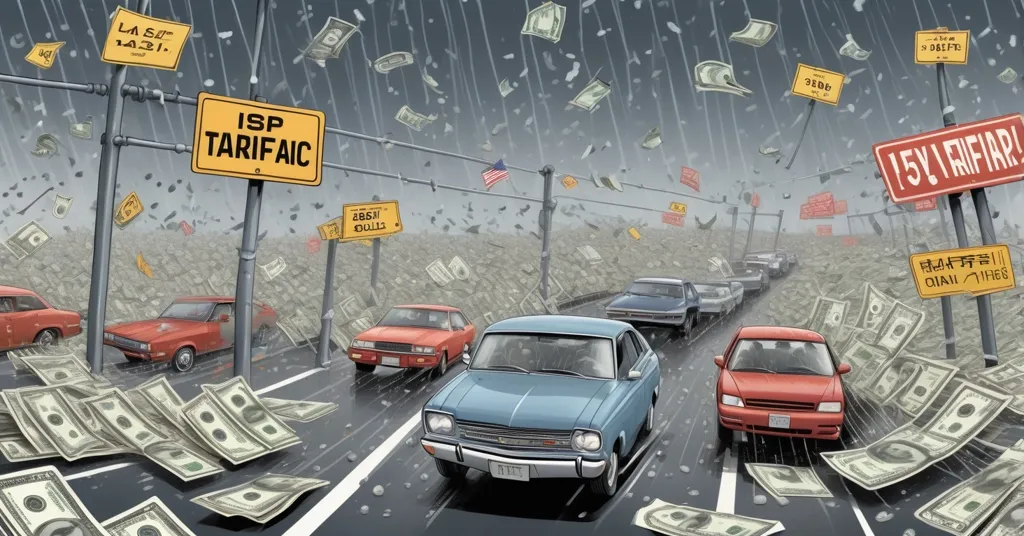US Tariff Cuts 2025: $700M Relief for EU Automakers, Japan Hit with $17B Losses

US Tariff Cuts 2025: $700M Boost for EU Automakers, Japanese Firms Still Reeling
A seismic shift in US trade policy has brought a much-needed lifeline to European Union (EU) automakers, slashing import tariffs and delivering a hefty financial reprieve, while Japanese manufacturers remain bogged down by the lingering effects of punitive trade barriers. This move, rooted in bilateral negotiations and economic trade-offs, reveals the stark disparities in how global players navigate the murky waters of international commerce.
- EU Windfall: Tariffs on EU vehicles drop from 27.5% to 15%, saving 500-600 million euros monthly (roughly $700M USD).
- Japanese Pain: Despite a similar cut to 15%, Japanese automakers report ¥2.6 trillion in losses ($17B USD) for April-June 2025.
- Uneven Ground: EU gains retroactive refunds; Japan gets no such relief, highlighting skewed trade dynamics.
The Tariff Rollercoaster: A Brief History
Understanding today’s tariff landscape requires a quick look back. Before the Trump administration, US import tariffs on vehicles from the EU hovered in the single digits, a manageable cost for foreign automakers. Japan faced similarly low barriers, fostering a relatively open market. Enter the late 2010s, when protectionist policies kicked into high gear. Tariffs skyrocketed to 27.5% for EU vehicles and 25% for Japanese cars and parts, a blunt move to shield American manufacturers like Ford and GM from overseas competition. The rationale? Boost domestic jobs and rebalance trade deficits. Critics, however, saw it as a sledgehammer approach, jacking up consumer prices and straining global supply chains. Fast forward to 2025, and the partial rollback to 15% for both regions signals a softening stance, though the damage of past policies still looms large, especially for some.
EU Automakers: A Half-Full Glass of Relief
As of August 1st, the US slashed its import tariff on EU vehicles from a brutal 27.5% to a still-stiff 15%, a change cemented in the Federal Register for customs enforcement. For giants like Volkswagen, BMW, and Mercedes-Benz, this translates to savings of 500-600 million euros per month—about $700 million USD, a sum that could rival the annual budget of a small nation. Better still, the deal includes retroactive refunds for overpaid tariffs since the reduction began, padding balance sheets at a time when the industry wrestles with supply chain chaos and the costly shift to electric vehicles (EVs). EU officials are framing this as a triumph, with Maros Sefcovic, the bloc’s lead trade official, striking a pragmatic tone. If you’re curious about the broader impact, check out more on the significant relief for automakers due to US tariff cuts.
“The best deal available… any other alternative would be much worse.” – Maros Sefcovic
European Commission President Ursula von der Leyen doubled down, presenting the tariff cut as a game-changer for EU manufacturers. But let’s not pretend everyone’s singing kumbaya. Some European business groups and members of the European Parliament are spitting venom over the agreement. Why? Because 15% is still highway robbery compared to the pre-Trump days of single-digit rates. For them, this “relief” feels like getting a discount on a punch to the face—it’s better than full price, but you’re still bruised. It’s a fair gripe: while $700 million in monthly savings is nothing to sneeze at, the elevated rate keeps EU firms at a disadvantage against domestic US competitors.
Japanese Automakers: Stuck in the Tariff Trenches
Meanwhile, Japanese automakers are getting the short end of the stick in this trade saga. Sure, they also secured a tariff reduction to 15% in September, but only after coughing up massive investments in US soil as a bargaining chip. And unlike the EU, there’s no retroactive refund to soften the blow. The financial carnage from earlier tariffs—pegged at 25% since April 2025—is staggering. For the April-June 2025 quarter, Nissan and Mazda bled red with outright losses. Mitsubishi Motors watched its income vanish into thin air. Honda’s earnings got chopped in half, while even heavyweights like Toyota and Subaru saw profits tank by over 30%. All told, the Japanese auto sector estimates a gut-punch of ¥2.6 trillion in operating profit losses—roughly $17 billion USD. That’s not pocket change; it’s the kind of hit that forces layoffs, R&D cuts, and panicked boardroom meetings.
Desperate to survive, these companies have slashed prices, eaten costs through their US sales arms, and propped up struggling parts suppliers. But the outlook remains grim, as one unnamed executive bluntly put it.
“It seems likely that America’s steep tariffs will stick around even after the Trump administration ends.” – Unnamed Japanese Executive
This talk of a “new normal” isn’t just pessimism—it’s a cold reality. Japanese firms can’t fully pass these costs to US consumers without losing market share in a cutthroat arena. The contrast with the EU’s cushier deal raises eyebrows. Why the disparity? Is it geopolitical favoritism, or just raw leverage from differing trade negotiations? Either way, Japan’s auto industry is left licking its wounds while the EU gets a pat on the back.
Tariffs 101: What’s Really at Stake?
For the uninitiated, let’s break down what a tariff actually is. Think of it as a tax slapped on imported goods—here, vehicles and parts from the EU and Japan—meant to make foreign products pricier and nudge buyers toward domestic options. The idea is to protect US automakers and jobs, a tactic the Trump administration wielded like a battle axe. But here’s the rub: tariffs often boomerang. They hike up car prices for American consumers, who end up footing the bill for “protection.” They also snarl global supply chains, as companies scramble to source parts from tariff-free zones or absorb losses. Bilateral trade agreements—deals between two nations to ease such barriers—can soften the impact, as seen with the EU’s recent win and Japan’s investment-tied reduction. Yet even at 15%, these taxes remain a hurdle, keeping foreign cars costlier than they’d be in a freer market.
Zooming in, the consumer angle can’t be ignored. A 15% tariff still inflates sticker prices on imported sedans, SUVs, and EVs, meaning US buyers shell out more at dealerships. It also slows the rollout of affordable electric models from overseas, a bitter pill as the world races to cut emissions. For automakers, it’s a constant juggling act: eat the cost and bleed profits, or pass it on and risk losing customers. This isn’t just economics—it’s a high-stakes poker game with billions on the table.
Trade as Power: The Bigger Picture
Let’s call a spade a spade: trade policies aren’t just about numbers; they’re about flexing muscle. The US wields tariffs as a bargaining tool, pressuring foreign nations and industries to bend to its economic will. The EU’s sweeter deal might reflect deeper transatlantic ties or savvier negotiation, while Japan’s steeper climb hints at tougher geopolitical dynamics. Add in the timing—2025 projections suggest ongoing global uncertainty—and you’ve got a recipe for continued friction. The automotive sector, already battered by chip shortages and the EV pivot, faces extra strain from these policies. For EU firms, $700 million monthly relief offers breathing room to fund innovation or weather downturns. Japanese players, though, risk falling behind, especially in the hyper-competitive US market where every dollar counts.
Here’s a wild card to chew on: could trade wars indirectly boost decentralized solutions? As cross-border costs soar, some automakers might eye blockchain tech to streamline supply chains—think transparent, tamper-proof tracking of parts from factory to showroom. Others could explore cryptocurrency for payments, dodging tariff-hit currencies or banking delays. It’s a long shot, but when traditional systems squeeze profits, radical alternatives start looking less crazy. Tariffs might just nudge industries toward the very disruption we champion.
What’s Next for Global Trade?
Peering into the future, the tariff game is far from over. With US political cycles in flux, future administrations could double down on protectionism or push for further cuts if domestic industries stabilize. A Japanese executive’s warning of persistent high rates suggests skepticism about meaningful change, and who can blame them? EU firms might lobby for a return to single-digit tariffs, but that hinges on broader trade talks or economic concessions. Meanwhile, Japanese automakers face a brutal calculus: relocate more production to the US (costly but tariff-dodging) or keep bleeding profits overseas. Industry watchers speculate that ongoing EV mandates and supply chain woes could force trade policies to adapt—tariffs on gas-guzzlers might ease if green tech becomes a priority. For now, it’s a waiting game, with billions in revenue hanging on the next policy twist.
Critical Questions Answered
- Why did the US cut tariffs on EU and Japanese vehicles?
The EU secured a reduction through a bilateral trade agreement, prioritizing economic cooperation, while Japan’s cut came after hefty investments in US infrastructure, a clear quid pro quo. - How do these changes hit EU automakers compared to Japanese ones?
EU companies save about $700 million USD monthly with retroactive refunds, a significant boost, while Japanese firms, despite the same 15% rate, suffer a $17 billion USD loss for April-June 2025 with no extra relief. - Why are some Europeans still pissed about the deal?
Despite the cut, a 15% tariff towers over the pre-Trump single-digit rates, leaving business groups and parliament members feeling shortchanged on a full return to fair trade. - What’s the long-term damage for Japanese automakers?
The “new normal” of high tariffs, even at 15%, threatens sustained profitability as companies struggle to absorb costs or cut prices without losing US market share. - Could tariffs shift again down the line?
Persistent high rates might outlast current US leadership, as hinted by a Japanese executive, pointing to ongoing trade tensions regardless of political changes. - Does this tie into decentralization or crypto at all?
Indirectly, yes—trade barriers could push automakers toward blockchain for supply chain efficiency or crypto for cross-border payments, bypassing traditional financial friction.



